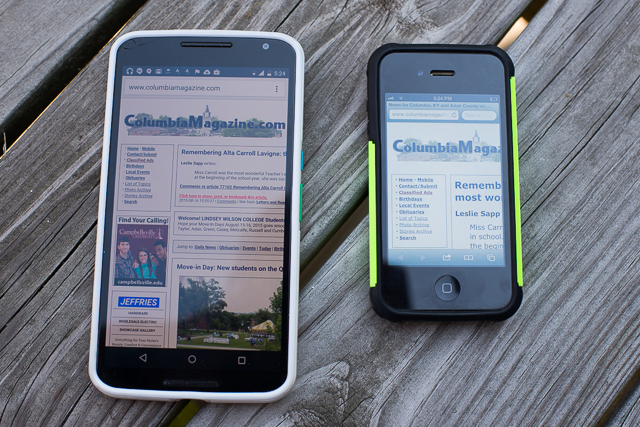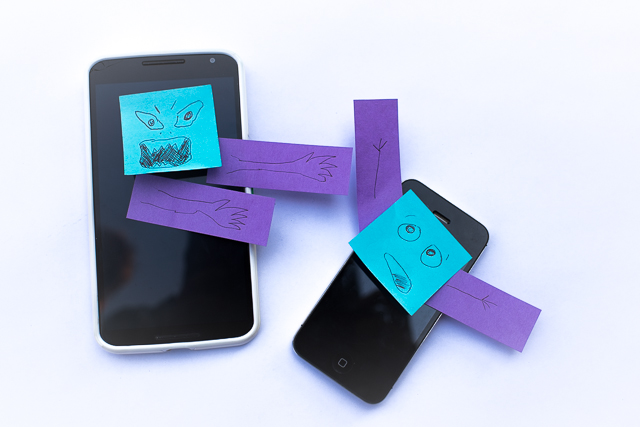| ||||||||||
Dr. Ronald P. Rogers CHIROPRACTOR Support for your body's natural healing capabilities 270-384-5554 Click here for details 


Columbia Gas Dept. GAS LEAK or GAS SMELL Contact Numbers 24 hrs/ 365 days 270-384-2006 or 9-1-1 Call before you dig Visit ColumbiaMagazine's Directory of Churches Addresses, times, phone numbers and more for churches in Adair County Find Great Stuff in ColumbiaMagazine's Classified Ads Antiques, Help Wanted, Autos, Real Estate, Legal Notices, More... 
|
KY-FI: Using Project Fi in the Bluegrass This is the first of a multipart series about the use of Google's new Network of Networks in the wilds of Kentucky. Project Fi looks to be a homerun in big cities, where Sprint and TMobile have solid coverage. Tom will find out how well it works in a more rural setting, and whether carting around the massive Nexus 6 is a reasonable compromise for $20/month unlimited talk and text. By Tom Waggener I come from a long line of men who hate the phone company and suspect that any and all charges incurred by phone usage are some manner of theft. The cellular age has been no different, and I have continally searched for the least offensive phone company available. Least offensive being cheapest, while allowing the most freedom, and occasionally listening as I get irate with customer service about a problem I clearly created. For the last 2 years, I have been on Ting, an MVNO that uses Sprint and AT&T towers, and it has been good for the most part. My biggest problem with Ting is that it is really not for heavy users of any sort, and I talk on the phone a lot. This has lead to an anxious frugality towards phone use, with me constantly chasing the best way to route calls via Google Hangouts and/or Google Voice, and frequently overthinking my cell phone usage while travelling. Googles Project Fi on paper sounds perfect for a phone-company-hater like myself. It primarily relies on a traditionally non-phone-related network: wifi (thus the "Fi"). Google's new "network of networks" defaults to wifi for everything whenever possible, which is great for them because wifi calls and data cost them nada. When not on wifi, or when leaving wifi, it "seamlessly" hands off to either T-Mobile or Sprint towers to maintain the call/Facebooks/Words with Friends. I use literal air quotes because the "seamless" seems like a stretch. I will be fervently testing this technology in my blog/long term review. If this is your first introduction to Google's Fi, here are a few things you need to know, some of which I already said:
Next: KY-FI: No Project Fi day 1 This story was posted on 2015-08-16 09:18:28
Printable: this page is now automatically formatted for printing.
Have comments or corrections for this story? Use our contact form and let us know.
More articles from topic Technology News:
Saturday Evening Connection Issues eTechCampus to expand operations in Lexington, KY Devin Morse, independent game developer at CU 26 Feb 2015 Tech Link: Tesla concept may revolutionize power grid Beshear, Hal Rogers, launch statewide broadband initiative Adair County High School observes Hour of Code Tech-Link: Chromebooks surpass iPads in Schools Free website development class 24 Sep 2014 The Flatwoods community, Adair Co., KY has access to 4G LTE AG Conway urges consumers to file claims in DRAM settlement View even more articles in topic Technology News |



|
||||||||
|
| ||||||||||
|
Quick Links to Popular Features
Looking for a story or picture? Try our Photo Archive or our Stories Archive for all the information that's appeared on ColumbiaMagazine.com. | ||||||||||
|
Contact us: Columbia Magazine and columbiamagazine.com are published by Linda Waggener and Pen Waggener, PO Box 906, Columbia, KY 42728. Please use our contact page, or send questions about technical issues with this site to webmaster@columbiamagazine.com. All logos and trademarks used on this site are property of their respective owners. All comments remain the property and responsibility of their posters, all articles and photos remain the property of their creators, and all the rest is copyright 1995-Present by Columbia Magazine. Privacy policy: use of this site requires no sharing of information. Voluntarily shared information may be published and made available to the public on this site and/or stored electronically. Anonymous submissions will be subject to additional verification. Cookies are not required to use our site. However, if you have cookies enabled in your web browser, some of our advertisers may use cookies for interest-based advertising across multiple domains. For more information about third-party advertising, visit the NAI web privacy site.
| ||||||||||





















































